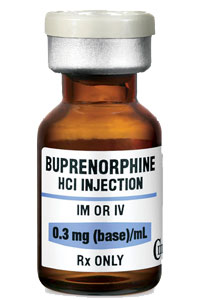Buprenorphine Treatment for Opioid Addiction
 Buprenorphine is a relatively weak opioid medication that doctors sometimes use to treat addictions to stronger legal and illegal opioids such as oxycodone (OxyContin), codeine, and heroin. Like other opioids, buprenorphine achieves its effects in the body by attaching to specialized sites on nerve cells (neurons) throughout the body called opioid receptors. However, it produces much smaller mind-altering effects than commonly abused opioids, and people recovering from addictions to those drugs can use buprenorphine to gradually transition through the withdrawal process, rather than going through severe withdrawal symptoms. In order to reduce any risks for inappropriate use, some forms of buprenorphine come combined with another drug called naloxone.
Buprenorphine is a relatively weak opioid medication that doctors sometimes use to treat addictions to stronger legal and illegal opioids such as oxycodone (OxyContin), codeine, and heroin. Like other opioids, buprenorphine achieves its effects in the body by attaching to specialized sites on nerve cells (neurons) throughout the body called opioid receptors. However, it produces much smaller mind-altering effects than commonly abused opioids, and people recovering from addictions to those drugs can use buprenorphine to gradually transition through the withdrawal process, rather than going through severe withdrawal symptoms. In order to reduce any risks for inappropriate use, some forms of buprenorphine come combined with another drug called naloxone.
The Basics
Opioid drugs of abuse such as heroin and oxycodone are known chemically as opioid full agonists. This means that they latch onto the opioid receptors on various neurons in the body and create very powerful drug effects, including intensely euphoric pleasure and disruption of the pain signals that normally flow into the central nervous system from the rest of the body. Typically, it is opioids’ ability to produce such intense pleasure that leads to intentional drug abuse and the eventual onset of opioid addiction.
While still an opioid like full opioid agonists, buprenorphine is known chemically as an opioid partial agonist. Like full agonists, it attaches itself to the body’s opioid receptors. However, once in place, the drug produces a level of euphoria that’s less than half as intense as the euphoria produced by heroin and other full agonists. In a person not used to the effects of opioid drugs, this level of mind alteration would be enough to trigger significant euphoria, and potentially lead to eventual involvement in abuse and addiction. However, in an opioid addict, the level of mind alteration produced by buprenorphine represents a major decrease in the normal intensity of drug effect. In supervised treatment, doctors can use this decrease in intensity to wean their patients off of stronger opioid drugs.
Specifics of Action
Buprenorphine has other properties that typically make it well-suited for the treatment of opioid addiction. Chief among these properties is its ability to cling unusually tightly to the body’s opioid receptors once attached. While other drugs lose their attachment to these receptors relatively quickly or easily, buprenorphine can stay in place for roughly three days in the average individual. As long as it’s in place, the drug blocks the attachment of any other opioid drug circulating in the system. In real-world terms, this means that if someone using buprenorphine takes a stronger opioid of abuse, that drug won’t gain access to the opioid receptors. Without this required access, the stronger drug can’t produce its addiction-supporting effects inside the body. In addition, past a certain moderate level of intake, buprenorphine itself does not get the user any “higher.” This fact largely diminishes any risks for buprenorphine abuse.
Side Effects
Relatively minor potential side effects of buprenorphine use include insomnia, increased sweat output, headaches, depression, anxiety, unexplained back pain, nausea, vomiting, unexplained stomach pain, constipation, chills, unusual tingling sensations in the body, and unusual levels of body warmth. More immediately serious potential side effects of the drug include abnormally slow breathing, abnormally shallow breathing, dizziness, the temporary loss of consciousness known as fainting, pain in the upper abdomen, jaundice, appetite loss, itchiness, unexplained changes in normal behaviors or thought patterns, and a confused mental state. People experiencing the drug’s serious side effects need to speak with their doctors as soon as possible. While buprenorphine is meant to reduce an addict’s chances of experiencing distressing withdrawal symptoms during recovery, in addicts with a heavy pattern of opioid use, it can actually produce a drop in the body’s opioid levels that’s severe enough to cause withdrawal symptoms on its own.
Considerations
Buprenorphine is available in forms that include a sublingual (under–the-tongue) tablet, an injectable liquid and thin film that sits on the skin. As noted previously, the drug presents relatively minor risks for use as a drug of abuse. Still, some addicts receiving the drug may attempt to exceed their prescribed dosages in an attempt to produce a “high.” In order to minimize this possibility, doctors can prescribe a form of the drug that also contains naloxone, a medication commonly used to reverse the effects of an opioid overdose. While doctors can prescribe several different buprenorphine products to treat other health problems, the only two forms of the drug approved for treatment of opioid addiction are called Suboxone and Subutex (the second of which contains both buprenorphine and naloxone).



